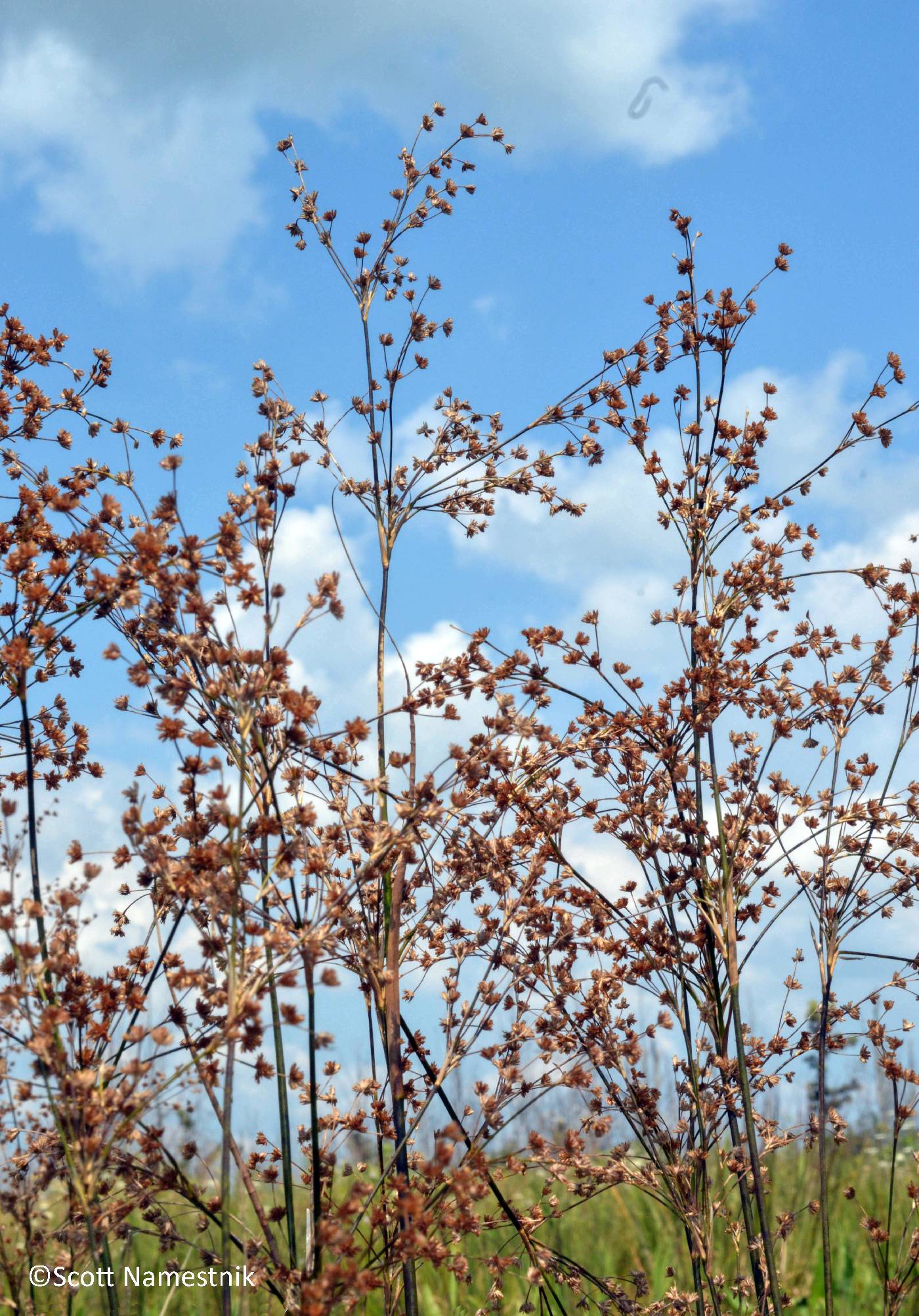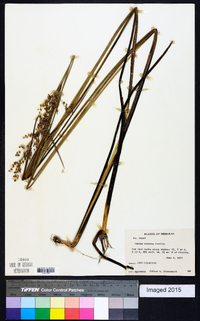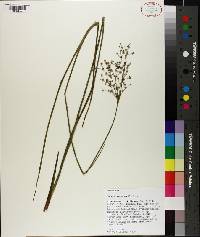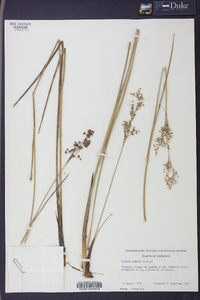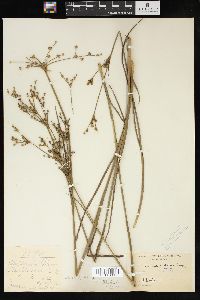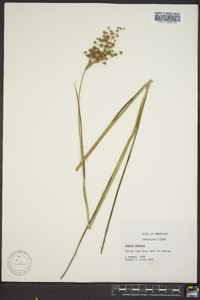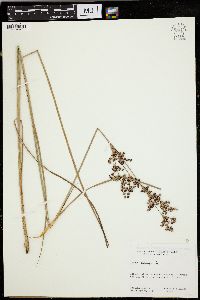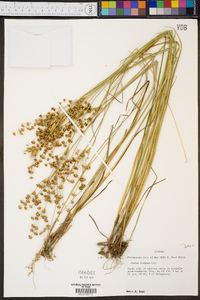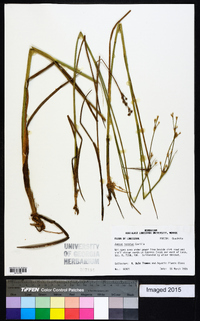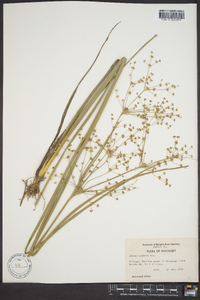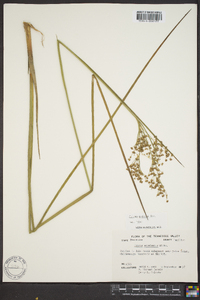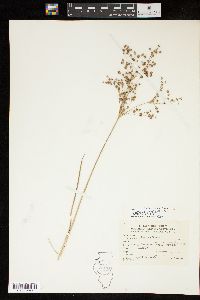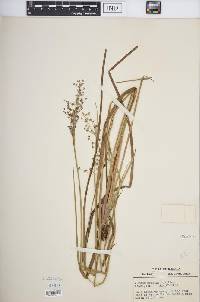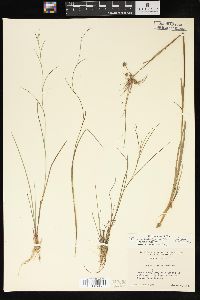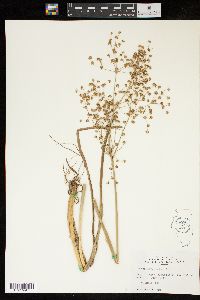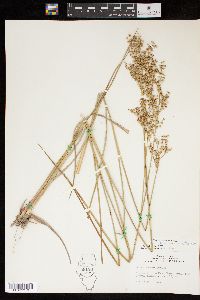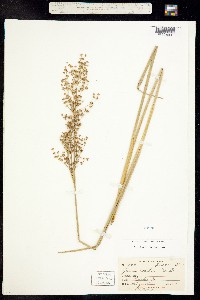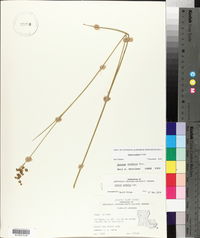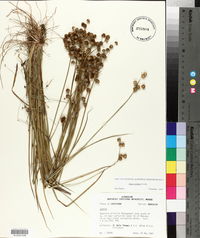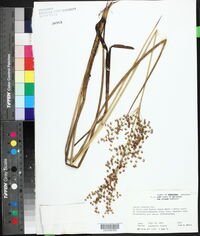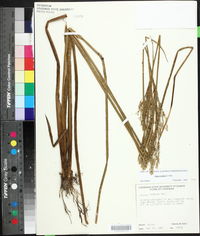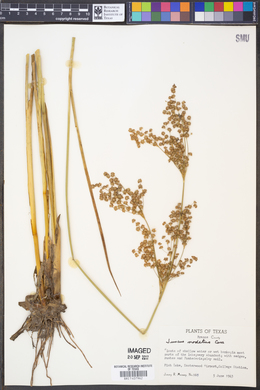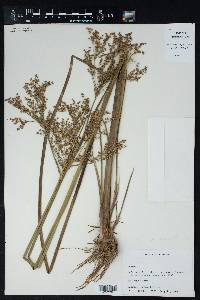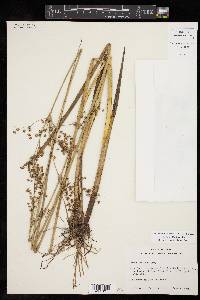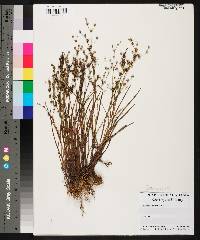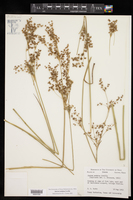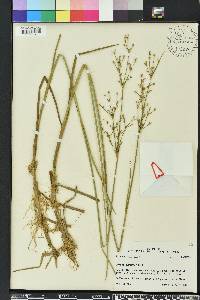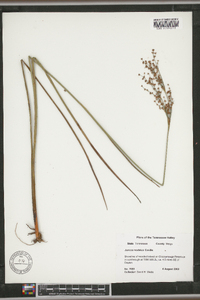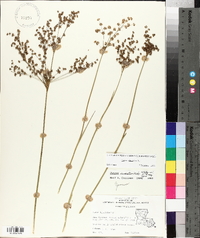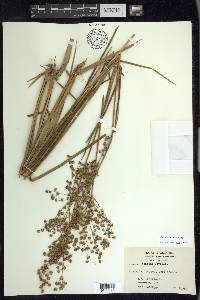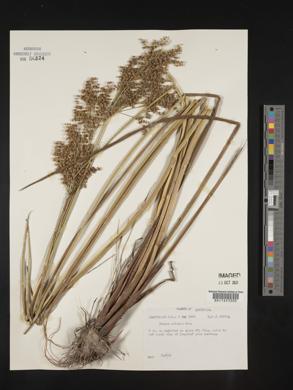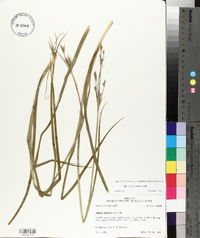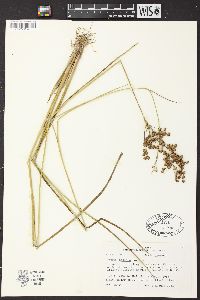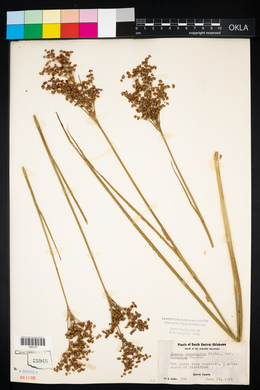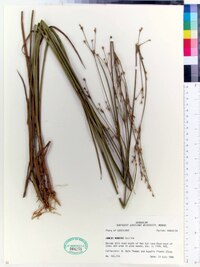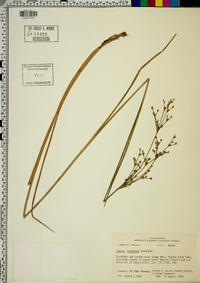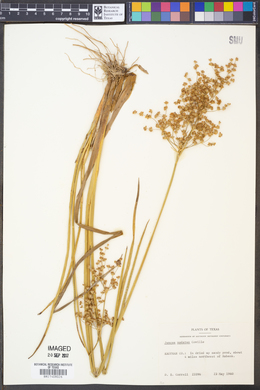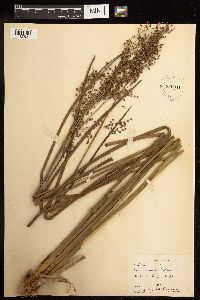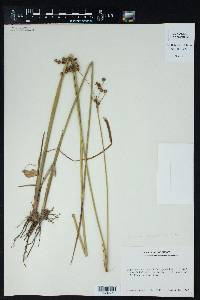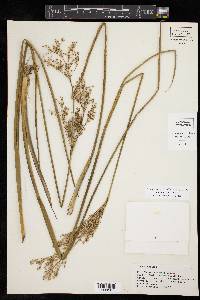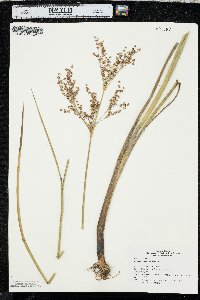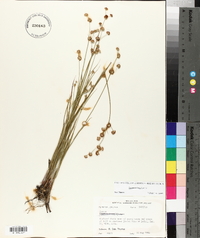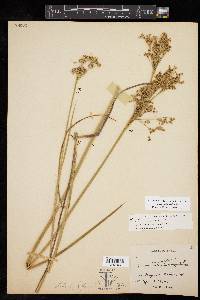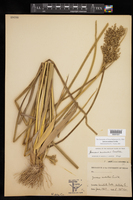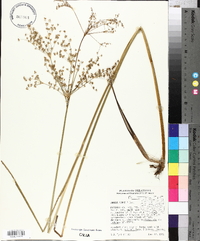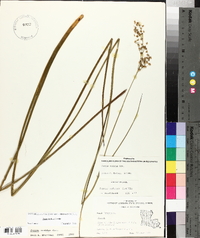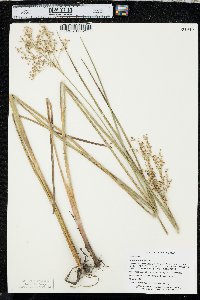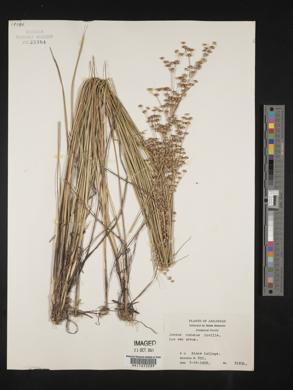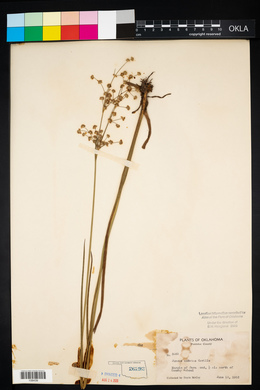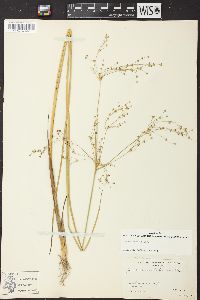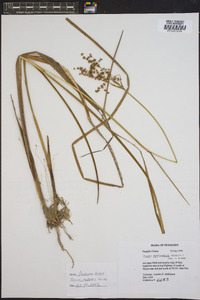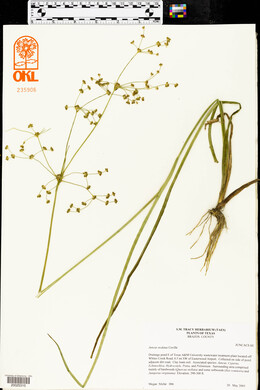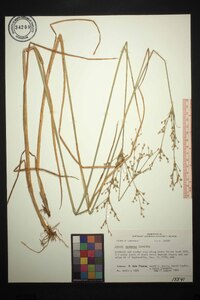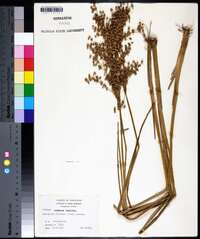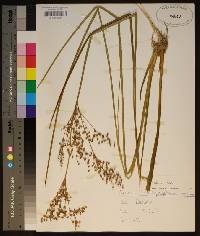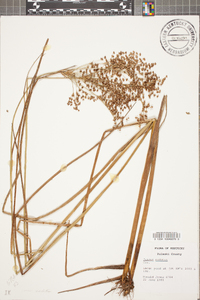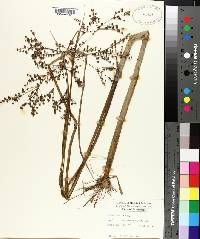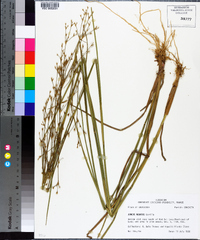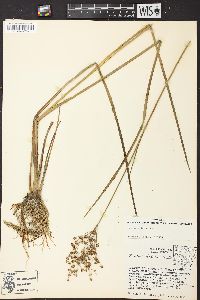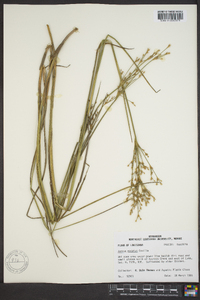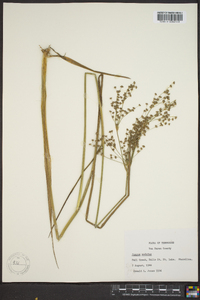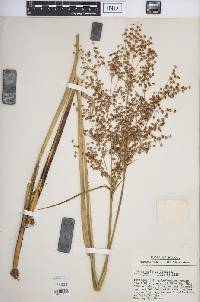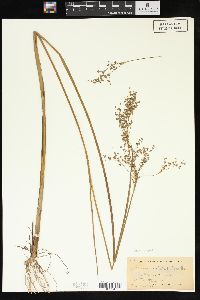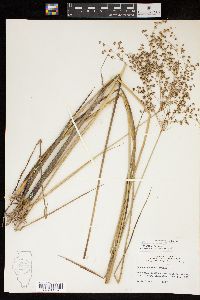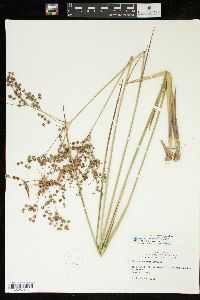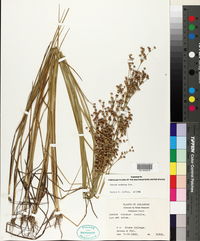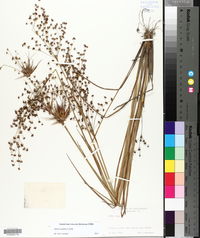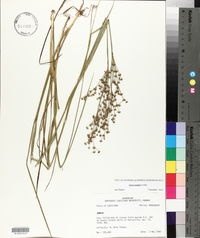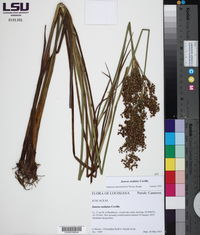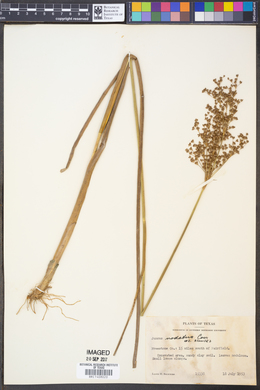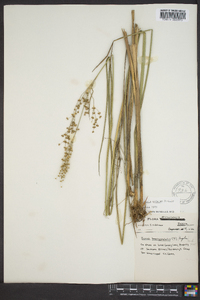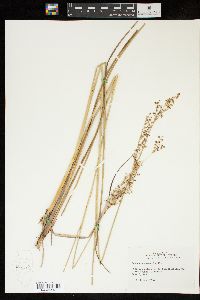
|
|
|
|
Family: Juncaceae
Stout Rush
|
Herbs, perennial, cespitose, 3--10 dm. Roots without terminal tubers. Culms erect, terete, 4--6 mm diam., smooth. Cataphylls 1--2, straw-colored, apex acute. Leaves: basal 1--2, cauline 1--2; auricles 1.2--1.5 mm, apex rounded, scarious; blade straw-colored or green, terete, 20--65 cm x 1.1--3.5 mm, with prominent and conspicuous ringlike bands at position of cross partitions; distal cauline leaves reduced to 2.5 cm. Inflorescences terminal panicles of 30--250 heads, 8--12 cm, branches spreading; primary bract erect to ascending; heads 2--10-flowered, broadly obovoid to hemispheric, 0.3--0.5 mm diam. Flowers: tepals straw-colored, lance-subulate, apex acuminate; outer tepals 1.9--2.2 mm; inner tepals 1.7--2.1 mm; stamens 3, anthers equal filament length. Capsules exserted, straw-colored, 1-locular, ovoid, 1.9--2.5 mm, apex acute, valves separating at dehiscence. Seeds oblong or ellipsoid, 0.5--0.6 mm, not tailed; body clear yellow-brown. Fruiting late spring--late summer. Commonly in shallow water, marshy shores, sloughs, wet flatwoods, and savannas, bogs, ditches, wet woods, shores, in standing water to 3 ft 1 m deep; 100--200 m; Ala., Ark., Fla., Ill., Ind., Kans., Ky., La., Mo., Okla., Tenn., Tex. Perennial grasslike forb 30 cm - 1 m tall Leaves: one or two basal and one or two alternate on stem, straw-colored or green, 20 - 65 cm long (but those furthest up stem only up to 2.5 cm), coarse (1.1 - 4 mm diameter), linear, grasslike, round in cross section, and with prominent ringlike bands on the outside at same position as crosswise partitions inside (septate). The leaves also have a thin and papery, basal, 1.2 - 1.5 mm long, round-tipped, ear-like appendage (auricle) at the top of the leaf sheath. Inflorescence: a terminal, 8 - 12 cm long, widely pyramidal, spreading, branched structure with branches ending in 30 to 250, hemispheric to inversely pyramidal, 0.3 - 0.5 cm diameter flower clusters. Each flower cluster is a compact head of two to ten, tiny, radially symmetric flowers. Stamens: three, with filaments and anthers about the same length. Pistil: with one superior ovary, and three stigmas. Fruit: single-chambered, straw-colored, taller than tepals (1.9 - 2.5 mm), egg-shaped, usually pointed-tipped capsules, which open down the sides. Stems: tufted, erect, smooth, stout, 4 - 6 mm in diameter, and round in cross section. Seeds: many, clear yellow-brown, 0.5 - 0.6 mm long, ellipsoid or oblong with short-pointed or abruptly narrowed tips, but without distinct narrowed tails at the ends. Tepals: six in two whorls of three, straw-colored, all about equal length, very narrowly lance-shaped with papery edges and long-tapered, slender, pointed tips. The three outer tepals may be slightly longer (1.9 - 2.2 mm) than the three inner tepals (1.7 - 2.1 mm). Similar species: In the Chicago Region, Juncus nodatus is probably most similar to J. acuminatus, but that species has much smaller inflorescences with normally only up to fifty heads, longer tepals (2.6 - 3.5 mm), and larger capsules (2.8 - 3.5 mm). The huge, spreading, and many-headed inflorescence of J. nodatus is very unique in our area. Flowering: June to July Habitat and ecology: Very rare, only in Jasper and Newton counties in Indiana where found in low sandy flats, pond borders or even ditches. Occurence in the Chicago region: native Notes: This is a more southern species that reaches its farthest north extent in northern Indiana. Etymology: Juncus is the classical name for Rush. Nodatus is Latin for "with nodes", in reference to the ringlike bands on the leaves at the position of the cross partitions. Author: The Field Museum Stems clustered, stout, erect, 6-12 dm, 3-10 mm thick at base; lvs coarse, elongate, terete and septate, the upper often reaching to the infl, the larger ones 3-5 mm thick; infl broadly pyramidal with numerous divaricate branches, decompound, 1-2 dm, with 200 or more obpyramidal, 2-7-fld heads 3-5 mm thick; fls eprophyllate; tep subequal, linear-subulate, much narrower than in the 2 preceding spp., scarious-margined, 1.9-2.6 mm; stamens 3; fr unilocular, pale brown, prismatically ovoid or long-trigonous, 2.1-2.8 mm, obtuse or subacute. Swamps and shallow water; n. Ind. to Kans., s. to Miss. and Tex. (J. robustus, a preoccupied name) Gleason, Henry A. & Cronquist, Arthur J. 1991. Manual of vascular plants of northeastern United States and adjacent Canada. lxxv + 910 pp. ©The New York Botanical Garden. All rights reserved. Used by permission. From Flora of Indiana (1940) by Charles C. Deam Infrequent and local. This southern species was apparently first collected in the state at its northernmost known station: along a wet railroad siding near Lake Maxinkuckee, Marshall County, J. T. Scovell and H. W. Clark no. 1468, Oct. 16, 1900. Its usual habitat in southern Indiana is on borders of ponds in low, often flooded, pin oak woods where it is associated with buttonbush and with Carex crus-corvi and C. lupuliformis. …… Indiana Coefficient of Conservatism: C = 7 Wetland Indicator Status: OBL |

